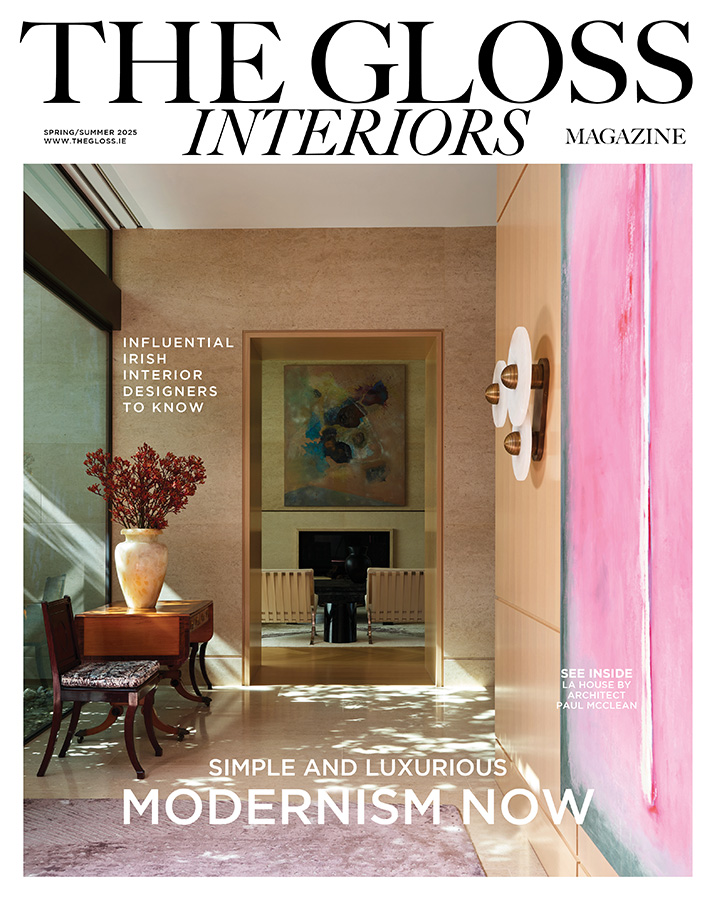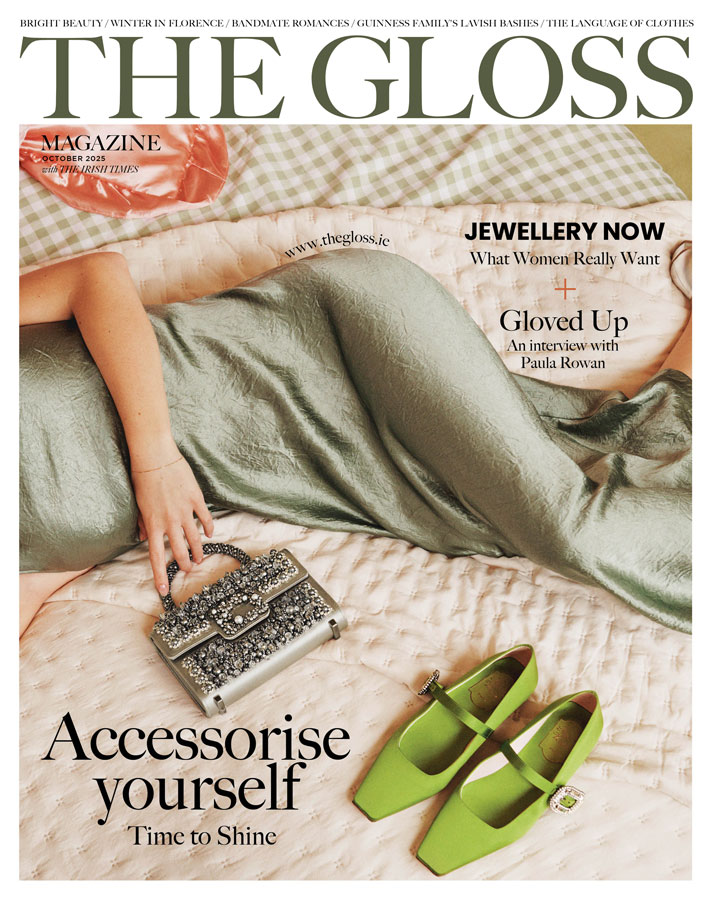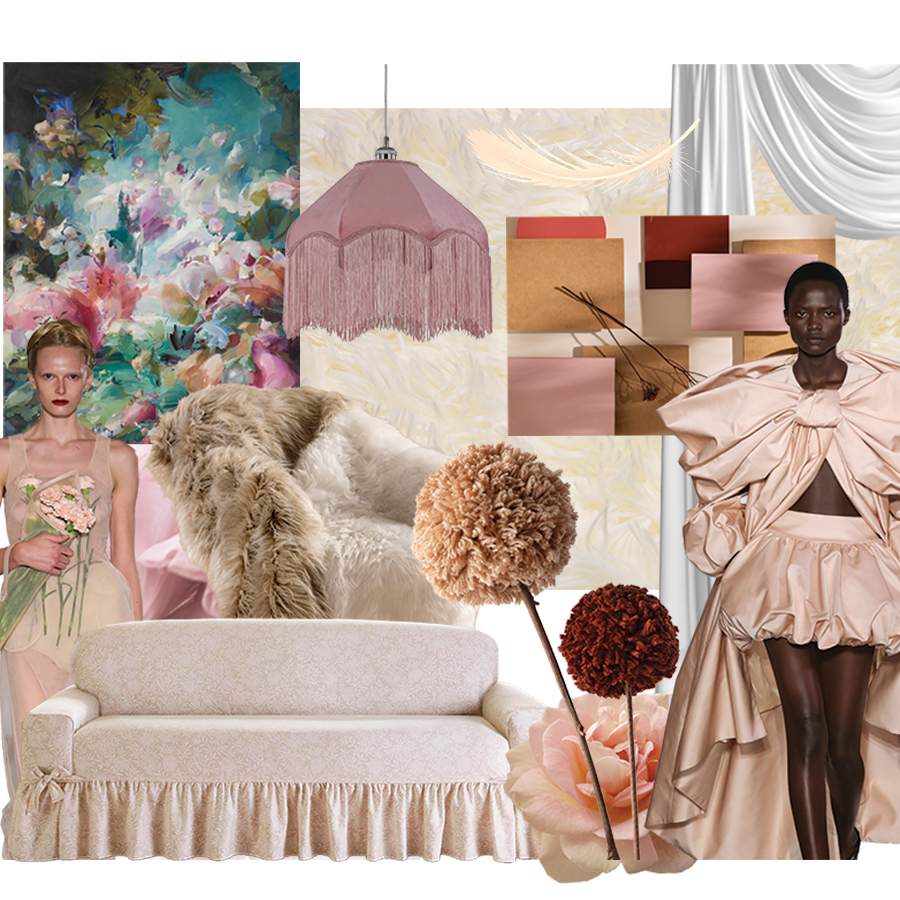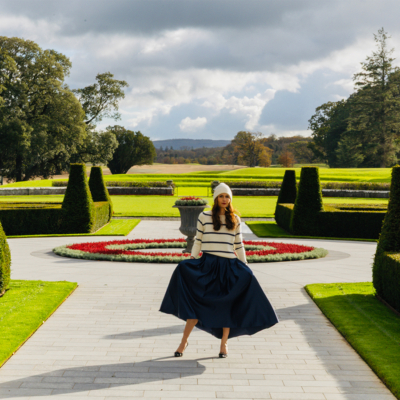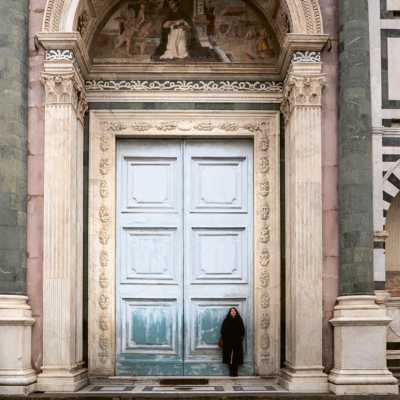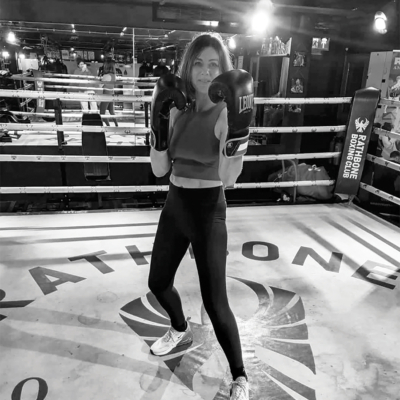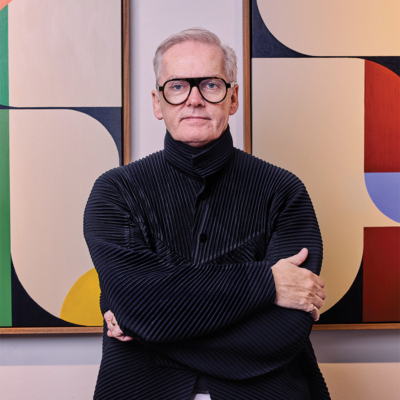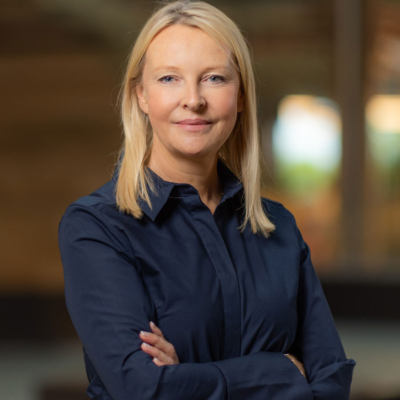Open up, look around and let softness in with a gentler mood reflected in this season’s fashion, interior and cultural trends …
Big, swooshing bows and puffall skirts at Simone Rocha. Dreamy light florals at Loewe and Prada. Regency-era collars at Valentino. With skirts going big, and sleeves even bigger, it’s clear that something is at play this season. Call it the return of boho chic, or the New New Romanticism, but everywhere you look, you’ll find the Great Softening. It’s in Maria Grazia Chiuri’s slouchy reinvention of Dior’s Bar Jacket, softened up to liberate the body. It’s giving a rose tint to the palette at Khaite, with motherhood prompting designer Catherine Holstein to infuse her predominantly black collections with soft pink. And it’s there in a whole trail of textures on the runway – from luxe velvet to brocade, faux fur cuffs to marabou trims, tiers of ruffles to flyaway fringing.
If spring/summer 2025 offers an overwhelming dress-up box of more-is-more maximalism, then crucial to the Great Softening is lightness. Paper-thin layers of airy chiffon, lace, and flowing silk ensure the body is gently draped, rather than swaddled in fabric. Asymmetric cuts swept over curves at Collina Strada, while Chloé presented a collection of frilly bloomers, peasant blouses and cascading dresses that created fluid, gossamer-light shapes. “The mood is light, weightless, sensual, and joyful,” said the brand’s new creative director Chemena Kamali, who in just two seasons at the helm has given a masterclass on how to make girlish pieces feel positively refined. Sheer panels and cut-outs were an elegant, version of softness at Prada and Hermès, while Simone Rocha and JW Anderson proved that even tutus can feel grown-up with the right styling.
“We’re all about reintroducing softness to our screen-addled lives, seeking solace from a pessimistic news cycle.”
Nicolas Ghesquière’s Louis Vuitton collection was themed around the idea of “soft power”: “a striking back-and-forth between two contradictory yet harmonious opposites. The suppleness of structure. Intractable lightness … The mechanics of fluidity”. This ping-pong game between classic tailoring and more voluminous shapes manifested in a host of soft-tailored silhouettes: balloon sleeves and cinched waists, slinky dresses with ruched details, tuffs of chiffon fanning out over capri pants. The collection threw some striking shapes, some not for the faint-hearted, and mastered proportion – adding spikes of volume to a relaxed, slouchy silhouette. It was also about inviting movement, with long, trailing skirts and layers of necklaces that swing as you sashay.
What’s behind this Great Softening? If fashion in the 2010s came to be defined by minimalist styles, it’s partly because clean lines, colour blocking and harsh contouring photographed well for Instagram, the era’s defining platform. In a decade bookended by recessions, it also dovetailed with a “girl boss” culture that told women to “lean in” and “hustle”. Flash forward to 2025, and we’re all about reintroducing softness to our screen-addled lives, not to mention seeking solace from a pessimistic news cycle. Concerns about climate prompt us to seek softness in our environment, replacing mowed lawns with pollinator corridors, and organic architectural forms made with renewable, natural materials. Our search for softness might also bely a wider quest for downtime, mindfulness, a return to nature – and perhaps a soupçon of nostalgia for a pre-digital era.
“In a heavy world, it’s important to have something frivolous and light.” Alessandro Michele, Valentino
For his first collection for Valentino, designer Alessandro Michele looked to the brand’s archives, particularly the halcyon days of the late 1960s, 1970s, and early 1980s, coming back from his deep dive with a dazzling array of lace tights, feathered caps, satin bows, ra-ra skirts, even Pierrot-esque ruffs. And yet with its mixing and matching across eras, the collection felt more like a celebration of theatricality, or an escape into another imaginative space, rather than a step back in time. “In a heavy world, it’s important to have something frivolous and light,” the designer remarked of the collection.
As always, fashion’s penchant for softness is mirrored in interior trends. Even minimalist spaces can embrace softness with the “organic modern” trend: creating a warm, inviting and natural vibe with curvilinear furniture, natural wood, and large earthenware vessels set against a palette of warm neutrals. (This would be a great backdrop for that Chloé collection.) On the more maximalist, nostalgic end of the trend spectrum, there’s the ongoing “grandmillennial” look – think cottagecore’s smarter, more urbane big sister, with Arts and Crafts Movement-inspired florals, velvet sofas, and a blend of vintage and contemporary pieces. A recent look inside fashion designer Pearl Lowe’s Somerset cottage (courtesy of YouTube account The Luxury Home Show) revealed scalloped velvet headboards, fringed lampshades, antique prints, an elaborate dried flower arrangement, and racks of vintage circus costumes. It’s the antithesis of the minimalist boxes we’ve become accustomed to seeing on real estate shows, where family life is supposed to unfold around hard-edged oversized granite kitchen islands. All well and good for a tech magnate with no children, hobbies (a cinema room doesn’t count), or sentimental trinkets – but the rest of us want colour and life, goddammit, we want stuff, and places to stash it away in.
“While hardness shatters, softness yields, adapts, and moves with the times, finding strength in fluidity.”
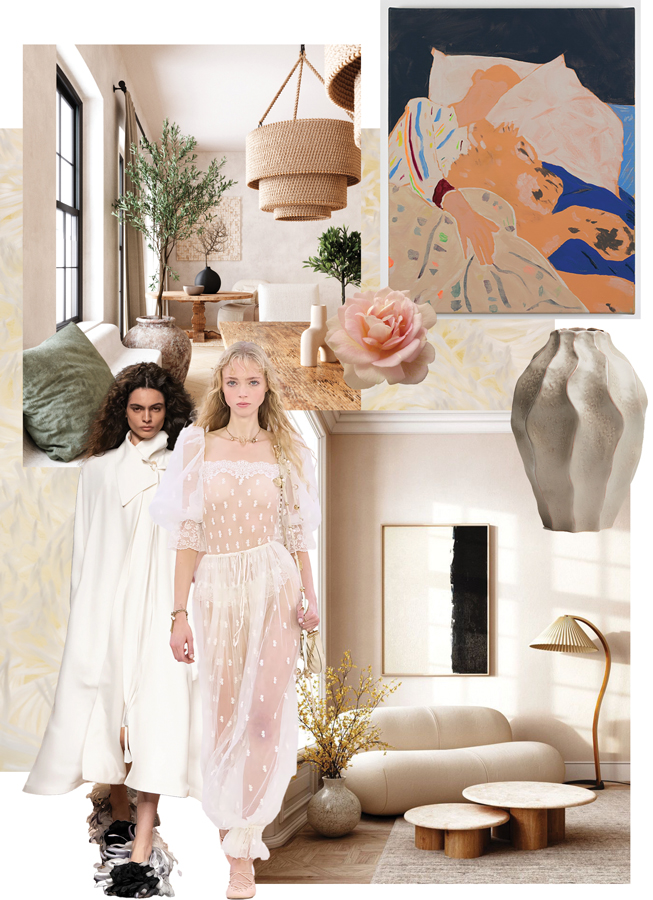
Unsurprisingly, the Great Softening has brought about a booming interest in soft furnishings, including some that have long been considered passé. Frilly sofa skirts and fringed cushions are back, while the recent TV reboot of Jilly Cooper’s Rivals has fuelled a rediscovery of swags, drapes, pelmets, and valances. Meanwhile Gen-Z is fuelling a hankering for thick, textured rugs and carpets: last year, Sofia Coppola’s Priscilla sent shag carpets viral with its opening scene of redpainted toenails sinking into pink wool. Such plush textures now seem decadent and sensual to a generation raised with 2000s-era laminate flooring. For those not ready to roll out the sheepskin, or festoon their space with silk swags, the oversized ribbon and bow trend looks set to continue – appearing on chairs, hooks, curtain tie-backs, candle-holders, flower arrangements and, well, anywhere that will accommodate them. As well as softness, it’s about inviting a sense of play, whimsy and girlish joy to an otherwise serious space.
This unabashed femininity is part of the appeal of the Great Softening. Anything pink, frilly, or frivolous has long been considered gauche by self-serious design types who tend to laud more austere, masculine-coded design movements like mid-century modern or brutalism. That tendency is now being flipped on its head by a new generation of creatives finding inspiration in the softer side of art and design history. Artist Flora Yukhnovich has become one of the biggest rising stars of the international art market for her lush, sweeping paintings in a soft bouquet of pinks and blues. She takes inspiration from Rococo, an exuberantly decorative – and much-maligned – 18th-century style typified by theatrical curves, florals, shells, and pastoral themes. “I’m intrigued by the idea of taste; by the way we use objects and patterns in our clothes and homes to express something of our interior selves,” she told an interviewer in 2020. “There are things we profess to like … in order to fit in with or impress others. And there are tastes which we hide … The Rococo is not a popular movement, so it holds some of that tension for me. The same goes for aesthetic languages traditionally associated with women and girls.”
“It’s time to make space, too, for ‘Soft Travel’ – for rediscovering the joy of meandering through unfamiliar streets.”
Is the Great Softening a form of rebellion, then, of reclamation of frills and femininity? Seeing it as part of a broader cultural shift, it could be read as a backlash not only to more sober and structured styles, but also an always-on work culture that makes little time for play. The “Soft Life” – a term coined by Nigerian influencers, and rapidly popularised on social media – describes a lifestyle that prioritises health, wellbeing and spending time with family over chasing a burnout-inducing work culture. Soft Life proponents advocate switching off (or limiting) phone noti? cations, taking up analogue activities like sketching, baking or gardening, and learning to appreciate what you already have, rather than always striving for more. It’s about making space to relax, breathe and tune in to the present moment, without the pressure of always having to optimise.
But living the Soft Life needn’t mean giving up ambition – if hardness shatters, softness yields, adapts, and moves with the times, finding strength in fluidity. Balanced with a focused approach to work, the Soft Life’s onus on rest and recovery might just help you go further – it’s about knowing when to switch on and off. Olympic gold medal winner Dina Asher-Smith gave a lesson in Soft Living when asked December last how she was prepping for the holiday period: “When so much of my life is times, counting reps and pushing through pain, there’s something really nice about just mindlessly roaming shops thinking about other people.” She is onto something: when did prepping for the holidays become a military operation?
It’s time to make space, too, for “Soft Travel” – for rediscovering the joy of meandering through unfamiliar streets. I plead guilty to over-planning big trips, watching hours of YouTube content on top destinations. But while a little light research can help build excitement, influencer culture has created gluts of tourists all visiting the same checklists of must-see sights, lining up to take the same photographs. Far from offering an escape, this type of travel can create the anti-climactic feeling of being trapped in an “Instagram vs Reality” meme. Soft Travel, instead, prizes the chance discovery: that charming taverna you stumble upon on your sunset ramble will probably be a whole lot more memorable than the trendy joint with 50 TikTokers lined up outside – be brave and abandon the strict itinerary. (Besides, in trying to see everything, sometimes we forget to actually stop and look. I’ll never forget being at the Capodimonte Museum in Naples and watching a pair of tourists walk right past the collection’s prized Titian – so fixated were they on studying the museum map.)
If the Great Softening can be applied to any area of our lives, then perhaps it’s really about an outlook. Embracing softness can shape the way we navigate the world, opening us up to receive new ideas, new sights, new encounters. In a divided political landscape, it’s about wielding tolerance and accepting uncertainty over hard-line polemics. In a world obsessed with productivity, it’s carving out space for a walk, reading, or catching up with a friend – and in a sea of unwarranted advice, it’s about tuning into your gut instincts. So as we ditch the shapewear and shimmy into a more cocooning silhouette, it’s worth thinking about where else we might invite softness into our lives. “Frivolousness is not useless”, as Alessandro Michele says, so let the season’s frills, bows and ruffles sweep in a new attitude – and reveal the hidden power of softness.



